Electrical emergencies can be dangerous and overwhelming. Whether it’s a power outage, a sparking outlet, or an electrical fire, knowing how to respond quickly and safely can make all the difference. Electrical issues not only pose a risk to personal safety but can also lead to property damage, making immediate action essential.
Understanding the correct steps to take after an electrical emergency can help prevent further hazards and ensure that your home remains safe. From shutting off power to contacting a professional, being prepared for unexpected electrical issues is crucial.
Identifying the Type of Electrical Emergency
Not all electrical emergencies are the same, and the appropriate response will depend on the type of issue you’re facing. Some of the most common electrical emergencies include power outages, short circuits, electrical fires, and exposed wiring.
Power outages may be caused by external factors such as severe weather or issues with the power grid, but they can also indicate a problem within your home’s wiring system. If your neighbors still have power while your home does not, there may be an issue with your electrical panel or internal wiring.
Sparking outlets, burning smells, and overheating electrical appliances can signal a short circuit. This occurs when electrical current flows in an unintended path, creating excess heat and potentially leading to fires.
Exposed wiring poses a significant risk of electrocution and should never be handled without professional assistance. If you notice frayed wires or damaged cables, they should be addressed immediately.
Shutting Off the Power to Prevent Further Damage
One of the first steps to take in an electrical emergency is to turn off the power supply. This helps prevent further damage and reduces the risk of electric shock or fire.
Locate your home’s electrical panel and turn off the main circuit breaker. If you suspect the issue is limited to a specific area, such as a faulty outlet or appliance, switch off the corresponding circuit instead of shutting off the entire power supply.
In cases where an electrical fire has started, never use water to extinguish the flames, as this can worsen the situation. Instead, use a fire extinguisher rated for electrical fires or call emergency services for assistance.
Avoiding Direct Contact with Electrical Hazards
Electrical emergencies often involve live wires, damaged appliances, or water-exposed outlets. Avoid touching any electrical components with bare hands, especially if standing on a wet surface. Water is a powerful conductor of electricity and increases the risk of shock.
If an appliance is sparking or overheating, unplug it from the wall if it is safe to do so. However, if unplugging poses a risk of electrocution, leave it alone and turn off the power source instead.
Never attempt to repair or tamper with electrical systems unless you have professional training. Improper handling can result in serious injuries or further damage to your home’s wiring.
Seeking Professional Assistance for Immediate Repairs
Once you’ve secured the area and minimized immediate risks, it’s crucial to contact a licensed electrician. Electrical emergencies should never be ignored or temporarily fixed without expert evaluation. A qualified after-hours electrician in Canberra can assess the problem, determine the cause of the emergency, and perform necessary repairs to restore safety. Emergency electricians are available 24/7 to handle urgent situations, ensuring that your home’s electrical system is functioning correctly and up to code.
Attempting DIY electrical repairs can be extremely dangerous and may lead to code violations, increased fire risks, or personal injury. Always rely on certified professionals to handle emergency electrical situations.
Checking for Electrical Damage After the Emergency
After the immediate crisis has been managed, it’s essential to inspect your home for any lingering electrical issues. This includes checking for damaged appliances, burnt outlets, and flickering lights.
If an electrical fire has occurred, assess the extent of the damage to walls, wiring, and fixtures. Some damage may not be immediately visible, making a professional inspection necessary.
Tripped breakers and blown fuses may indicate underlying problems with the electrical system. If your breakers continue to trip frequently, this could be a sign of faulty wiring or an overloaded circuit.
Preventing Future Electrical Emergencies
While some electrical emergencies are unavoidable, many can be prevented with regular maintenance and proper precautions. Scheduling routine inspections with a licensed electrician ensures that your home’s wiring, outlets, and electrical panel remain in good condition.
Avoid overloading circuits by plugging too many high-powered devices into the same outlet. Using surge protectors and upgrading outdated wiring can also help minimize risks.
Pay attention to warning signs of potential electrical hazards, such as flickering lights, buzzing sounds from outlets, or outlets that feel warm to the touch. Addressing minor issues before they escalate can prevent costly damage and dangerous emergencies.
Electrical emergencies can be dangerous and disruptive, but knowing how to respond effectively can help protect both your home and your family. Turning off power, avoiding direct contact with electrical hazards, and calling a professional electrician are essential steps in handling emergencies safely.
By staying proactive with maintenance and safety measures, homeowners can reduce the likelihood of electrical issues and ensure their homes remain secure. Making electrical safety a priority provides peace of mind and long-term protection against potential risks.


